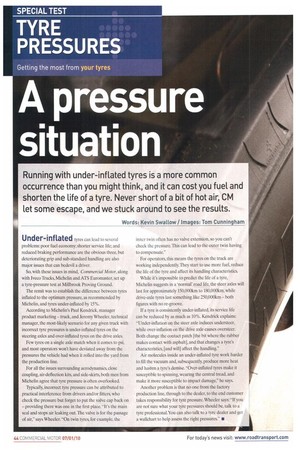A pressure situation
Page 44

If you've noticed an error in this article please click here to report it so we can fix it.
Running with under-inflated tyres is a more common occurrence than you might think, and it can cost you fuel and shorten the life of a tyre. Never short of a bit of hot air, CM let some escape, and we stuck around to see the results.
Words: Kevin Swallow / Images: Tom Cunningham Under-inflated tyres can lead to several problems: poor fuel economy; shorter service life; and reduced braking performance are the obvious three, but deteriorating grip and sub-standard handling are also major issues that can bedevil a driver.
So, with these issues in mind, Commercial Motor, along with lveco Trucks, Michelin and ATS Euromaster, set up a tyre-pressure test at Millbrook Proving Ground.
The remit was to establish the difference between tyres inflated to the optimum pressure, as recommended by Michelin, and tyres under-inflated by 15%.
According to Michelin's Paul Kendrick, manager product marketing truck, and Jeremy Wheeler, technical manager, the most-likely scenario for any given truck with incorrect tyre pressures is under-inflated tyres on the steering axles and over-inflated tyres on the drive axles.
Few tyres on a single axle match when it comes to psi, and most operators won't have deviated away from the pressures the vehicle had when it rolled into the yard from the production line.
For all the issues surrounding aerodynamics, close coupling, air-deflection kits, and side-skirts, both men from Michelin agree that tyre pressure is often overlooked.
Typically, incorrect tyre pressure can be attributed to practical interference from drivers and/or fitters, who check the pressure but forget to put the valve cap back on providing there was one in the first place. "It's the main seal and stops air leaking out The valve is for the passage of air," says Wheeler. "On twin tyres, for example, the inner twin often has no valve extension, so you can't cheek the pressure. This can lead to the outer twin having to compensate."
For operators, this means the tyres on the truck are working independently. They start to use more fuel, reduce the life of the tyre and affect its handling characteristics.
While it's impossible to predict the life of a tyre, Michelin suggests in a 'normal' road life, the steer axles will last for approximately 150,000km to 180,000km, while drive-axle tyres last something like 250,000km both figures with no re-groove.
If a tyre is consistently under-inflated, its service life can be reduced by as much as 10%. Kendrick explains: "Under-inflation on the steer axle induces understeer, while over-inflation on the drive axle causes oversteer. Both change the contact patch [the bit where the rubber makes contact with asphalt], and that changes a tyre's characteristics, land will] affect the handling."
Air molecules inside an under-inflated tyre work harder to fill the vacuum and, subsequently, produce more heat and hasten a tyre's demise. "Over-inflated tyres make it susceptible to spinning, wearing the central tread, and make it more susceptible to impact damage," he says.
Another problem is that no one from the factory production line, through to the dealer, to the end customer takes responsibility for tyre pressure. Wheeler says: "If you are not sure what your tyre pressures should be, talk to a tyre professional.You can also talk to a tyre dealer and gel a wallchart to help assess the right pressures."




























































































































